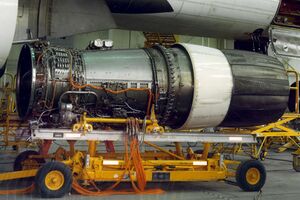Engineering:General Electric F101
| F101 | |
|---|---|

| |
| A General Electric F101 engine | |
| Type | Turbofan |
| National origin | United States |
| Manufacturer | General Electric |
| First run | 1970s |
| Major applications | Rockwell B-1 Lancer |
| Developed into | General Electric F110 CFM International CFM56 |
The General Electric F101 is an afterburning turbofan jet engine. It powers the Rockwell B-1 Lancer strategic bomber fleet of the USAF. In full afterburner it produces a thrust of more than 30,000 pounds-force (130 kN). The F101 was GE's first turbofan with an afterburner.[1]
Development
The F101 was developed specifically for the Advanced Manned Strategic Aircraft, which became the B-1A. The F101 powered the four development aircraft from 1970 to 1981. The B-1A was officially cancelled in 1977. However the flight test program continued. General Electric was awarded a contract to further develop the F101-102 engine variant. This turbofan eventually powered the B-1B from 1984, entering service in 1986. The B-1's four F101 engines helped the aircraft win 61 world records for speed, payload and range.
The GE F110 fighter engine is a derivative of the F101, designed using data from the F101-powered variant of the F-16 Fighting Falcon tested in the early 1980s. The F101 also became the basis for the highly successful CFM56 series of civil turbofans.
Applications
Specifications (F101-GE-102)
Data from [2]
General characteristics
- Type: Turbofan engine
- Length: 181 in (460 cm)
- Diameter: 55 in (140 cm)
- Dry weight: 4,400 lb (2,000 kg)
Components
- Compressor: Axial, 2 stage fan, 9 stage HP compressor
- Combustors: Annular
- Turbine: 1 stage HP turbine, 2 stage LP turbine
Performance
- Maximum thrust: 17,390 lbf (77.4 kN) (dry), 30,780 lbf (136.9 kN) (with afterburner)
- Overall pressure ratio: 26.8:1
- Specific fuel consumption: 0.562 lb/lbf/h (57.3 kg/kN/h) (dry thrust),
2.46 lb/lbf/h (251 kg/kN/h) (with afterburner) - Thrust-to-weight ratio: 7.04:1 (afterburner)
See also
Related development
Comparable engines
Related lists
References
- ↑ GE's F101 web page
- ↑ Gas Turbine Engines. Aviation Week & Space Technology 2009 Source Book. p. 118.
External links
 |

